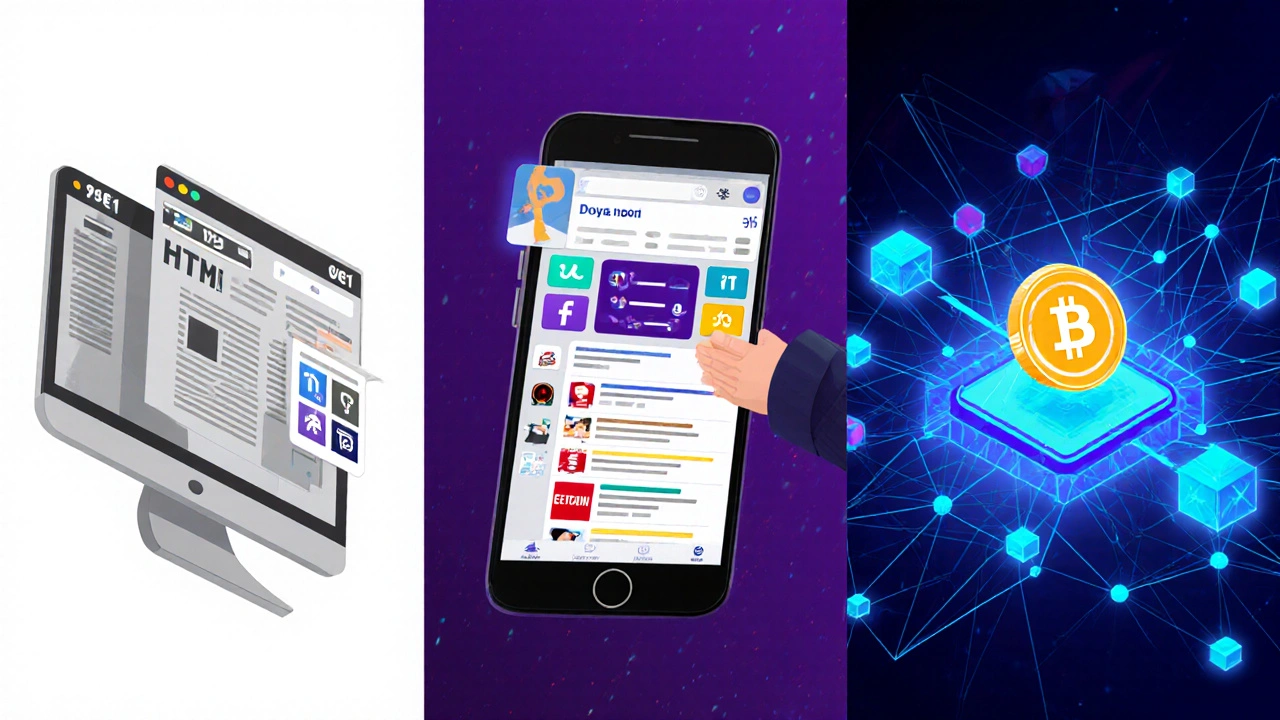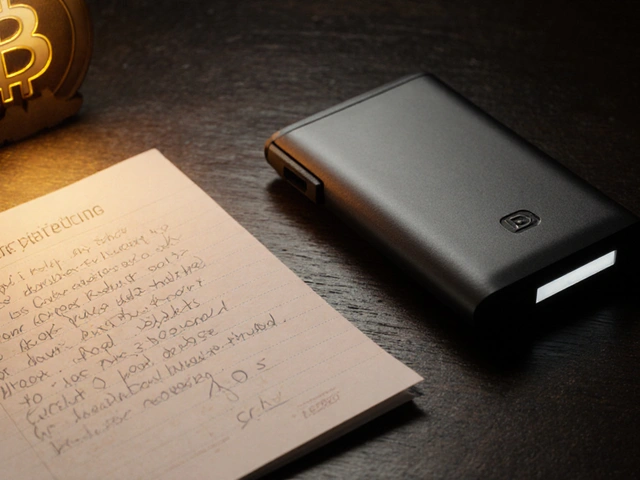Web3 Explained: The Basics of Crypto’s Next Evolution
When you hear Web3 mentioned in crypto circles, it can sound like a futuristic buzzword. In reality, it’s simply the next version of the internet-one that gives users more control over their data, assets, and online identity.
Quick Summary
- Web3 is a decentralized web built on blockchain technology.
- It lets users own digital assets directly, without relying on big platforms.
- Key components include smart contracts, tokenomics, DeFi, NFTs, and the metaverse.
- Benefits: greater privacy, new economic models, and open innovation.
- Challenges: scalability, regulation, and user experience hurdles.
What is Web3?
Web3 is a decentralized version of the internet that runs on blockchain networks, letting users interact directly with each other and with digital assets without a central authority. Imagine a marketplace where you can buy, sell, or trade items without a middleman taking a cut-that’s the essence of Web3.
In the crypto world, Web3 and cryptocurrency are tightly linked because the same blockchain protocols that power Bitcoin, Ethereum, and newer tokens also enable the decentralized services that define Web3.
Web1, Web2, and Web3: A Quick Comparison
| Aspect | Web1 (1990s) | Web2 (2000s‑2020s) | Web3 (2020s‑Future) |
|---|---|---|---|
| Control | Read‑only, static pages | User‑generated content, platforms own data | Users own data and assets via wallets |
| Monetization | Advertising‑free, minimal | Ad‑driven, subscription models | Token‑based incentives, on‑chain payments |
| Trust Model | Central servers | Big tech intermediaries | Decentralized consensus (blockchain) |
| Key Technology | HTML, HTTP | APIs, cloud services | Blockchain, smart contracts, DAOs |
Core Technologies Behind Web3
Blockchain is a distributed ledger that records transactions in an immutable, tamper‑proof way. All major Web3 services run on one or more blockchains, most commonly Ethereum or newer layer‑2 solutions.
Smart contracts are self‑executing code stored on the blockchain. They automatically enforce agreements without a middleman.
Smart Contract code that runs on a blockchain, executing predefined rules when conditions are met enable everything from token swaps to decentralized games.
Tokenomics describes how a project's native token is created, distributed, and used within its ecosystem. Good tokenomics drive network effects and user participation.
Decentralized Finance (DeFi financial services built on open‑source blockchain protocols, eliminating banks and brokers) lets anyone lend, borrow, or trade assets directly from a wallet.
Non‑Fungible Tokens (NFT unique digital tokens that represent ownership of a specific item, artwork, or piece of data) are the building blocks of digital collectibles, virtual land, and even ticketing.
The Metaverse a persistent, immersive virtual world where users can interact, create, and trade assets is often powered by Web3 standards, letting users truly own in‑game items.
Real‑World Crypto Use Cases Powered by Web3
- Decentralized Exchanges (DEXs): Platforms like Uniswap let you swap tokens directly from your wallet, removing the need for a centralized order book.
- Yield Farming & Staking: Users lock tokens in smart contracts to earn interest or new tokens, creating new income streams.
- Gaming & Play‑to‑Earn: Games such as Axie Infinity reward players with NFT characters that have real market value.
- Digital Identity: Projects like ENS (Ethereum Name Service) let you register a human‑readable name that points to your wallet address, simplifying payments and logins.
- Supply‑Chain Transparency: Blockchain records verify product provenance, useful for food safety, luxury goods, and pharmaceuticals.
Benefits and Challenges of Web3
Benefits
- Ownership: Users control their data and assets via private keys.
- Open Innovation: Anyone can build on open protocols, lowering entry barriers.
- Financial Inclusion: People without bank accounts can access DeFi services globally.
- Censorship Resistance: No single entity can shut down a decentralized app.
Challenges
- Scalability: Public blockchains still process far fewer transactions per second than Visa or Mastercard.
- User Experience: Managing wallets, gas fees, and private keys can be intimidating.
- Regulatory Uncertainty: Governments are still defining rules around tokens, DeFi, and NFTs.
- Security Risks: Bugs in smart contracts can lead to massive loss of funds.
Getting Started with Web3 (A Simple Checklist)
- Set Up a Non‑Custodial Wallet: Download MetaMask, Trust Wallet, or a hardware wallet like Ledger. Write down the seed phrase securely.
- Buy Some Crypto: Purchase ETH or a layer‑2 token on a reputable exchange (Coinbase, Kraken) and transfer it to your wallet.
- Explore a DApp: Visit a decentralized exchange (Uniswap), connect your wallet, and try a small token swap.
- Learn About Gas Fees: Understand how transaction costs work and consider using layer‑2 solutions (Arbitrum, Optimism) for cheaper trades.
- Secure Your Assets: Enable two‑factor authentication on exchanges, use hardware wallets for large holdings, and never share your private key.
- Stay Informed: Follow reputable sources (The Block, Messari) and join community chats on Discord or Telegram.
Mini FAQ
Is Web3 the same as cryptocurrency?
Cryptocurrency is one of the building blocks of Web3, but Web3 is broader-it includes decentralized apps, tokenized assets, and new governance models beyond just coins.
Do I need a lot of technical knowledge to use Web3?
No. Modern wallets and DApp browsers are designed for beginners. However, understanding private keys and gas fees is essential for safety.
What are the main risks of Web3 investments?
Smart‑contract bugs, volatile token prices, regulatory crackdowns, and scams (e.g., rug pulls). Diversify and only invest what you can afford to lose.
Can Web3 improve data privacy?
Yes. Because data lives on a public ledger, users control access through cryptographic keys rather than handing it to a central service.
Is the metaverse part of Web3?
The metaverse often relies on Web3 principles-ownership of virtual land, avatars, and items via NFTs, all powered by blockchain networks.
Next Steps & Troubleshooting
If you hit a “transaction failed” error, check two things: (1) your wallet has enough ETH to cover gas, and (2) the network isn’t congested. Switching to a layer‑2 or a less‑busy sidechain can resolve most hiccups.
For users concerned about security, move any sizable holdings to a hardware wallet. Keep the seed phrase offline-never store it in cloud notes.
Finally, keep an eye on emerging standards like ERC‑4337 (account abstraction) that promise smoother onboarding and better UX for newcomers.






8 Comments
Ronnie Kaye
October 17 2025Wow, Web3, the *next* evolution-because what the internet really needed was another buzzword to hype up the same old promises, right? But hey, if you love the idea of finally owning your data and not giving it away for free to the big tech overlords, then dive in! Grab a wallet, toss in a few pennies, and watch as you become a sovereign digital citizen. Just remember to keep that private key safe, unless you enjoy giving your crypto to random scammers. Good luck, and may the gas fees be ever in your favor.
Ian Maggs
October 17 2025Indeed, the philosophical underpinnings of decentralization, which trace back to the libertarian notions of trustless systems, compel us to reconsider the ontology of ownership; furthermore, the emergent tokenomics, replete with incentive-aligned mechanisms, represent a paradigmatic shift in economic theory-yet one must not overlook the epistemic opacity inherent in smart contract code, which can, paradoxically, both empower and imperil the participant.
Michael Gradwell
October 18 2025Web3 is just a marketing gimmick, stop chasing it.
Flannery Smail
October 18 2025Sure, if you think the internet was perfect before, you probably still use dial‑up.
Samar Omar
October 18 2025One cannot simply dismiss Web3 as a passing fad without first acknowledging the profound philosophical ramifications it introduces to our collective digital consciousness; the very notion of assigning sovereign ownership to digital artifacts challenges centuries‑old legal doctrines that were never conceived to accommodate code‑based assets. Moreover, the emergence of decentralized autonomous organizations (DAOs) heralds a new era of participatory governance, wherein decision‑making is codified into immutable contracts rather than opaque boardrooms. This shift, while exhilarating, also demands a radical re‑education of the populace, for the average netizen must now grapple with private keys, gas fees, and the existential dread of a lost seed phrase. Yet, in the grand tapestry of technological progress, such growing pains are inevitable, reminiscent of the early days of the web when HTML tables were considered cutting‑edge. The token‑driven incentive structures, meticulously engineered through tokenomics, aim to align individual motivations with network health, thereby fostering a virtuous cycle of contribution and reward. In practice, this has already manifested in vibrant ecosystems ranging from decentralized finance platforms that democratize access to capital, to play‑to‑earn games where players can monetize their in‑game achievements. Critics, of course, point to scalability bottlenecks and regulatory uncertainty; however, the relentless innovation in layer‑2 solutions and cross‑chain bridges suggests that these hurdles are surmountable. The philosophical discourse surrounding data sovereignty also invites us to reconsider privacy not as a mere convenience, but as an intrinsic human right, now technically enforceable via cryptographic primitives. As we stand on the precipice of this decentralized renaissance, it becomes incumbent upon scholars, developers, and users alike to engage in rigorous dialogue, lest we repeat the mistakes of the centralized internet era, where power consolidated in the hands of a few. In essence, Web3 is not merely a technological upgrade; it is a cultural metamorphosis that beckons us to reimagine identity, value, and community in the digital age.
chioma okwara
October 18 2025First off, the term “Web3” isn’t some mystical creature-it’s simply the next iteration of the internet, built on blockchain tech; second, you don’t need to be a coding wizard to use a wallet, just follow the step‑by‑step guides on reputable sites, and third, always double‑check the contract address before you click “approve,” otherwise you’ll end up losing funds to a rug pull. Also, don’t forget that “gas” fees can fluctuate wildly, so timing your transactions during low‑traffic periods can save you a decent amount of crypto. Finally, keep your seed phrase offline-never type it into a web page, even if it looks legit.
John Fox
October 18 2025Just another day in the crypto wild west.
Tasha Hernandez
October 19 2025Oh, the glorious utopia of Web3-where every token is a shining beacon of hope, and every “decentralized” project is secretly funded by the same venture‑capital overlords we pretended to despise. It’s absolutely heart‑warming to watch people trade NFTs like they’re rare Pokémon cards, all while the underlying code is riddled with bugs that could evaporate their entire portfolio in a single block. And let’s not forget the endless parade of “self‑sovereign identities” that, in reality, just replace one password with a 12‑word phrase you’ll inevitably lose after the third coffee spill. Yet, despite this circus, we keep marching, because the promise of financial freedom sounds so much sweeter than admitting we’re all just chasing the next hype wave. So grab your ledger, embrace the drama, and enjoy the roller‑coaster ride-just make sure you scream loudly when the market crashes.